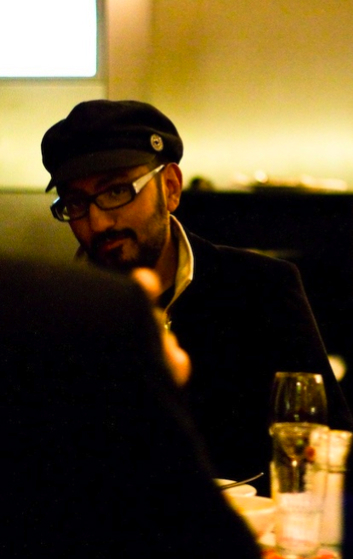イブラヒム・クレイシーIbrahim Quraishi

イブラヒム・クレイシーは、パキスタン国籍でアムステルダム在住のマルチメディアアーチスト。移動のリアリティとダイナミクス、想像社会の中の厳格なる社会政治的領域におけるIbrahim Quraishi is a multidisciplinary artist born in 1973. His works consciously examine the realities and dynamics of migration, dispossession and cohabitation within the highly rigid非占有またはその同居を作品の中で意識的に検証している。
![]()
![]()
はじめに、自己紹介をお願いします。
![]()
イブラヒム・クレイシー。マルチメディアアーチストで、映像制作やインスタレーション、パフォーマンスなどを行っています。主に、大衆とインテリ間の文化トレンドに関与する従来あるルールに問いを投げかけつつ都市のありふれた概念に関心を寄せています。また場所と特定した作品制作を行い、21世紀の一部と化しています。放浪的な存在をその特徴とするアムステルダムが、僕の本拠地です。最近の活動では、キューバを舞台に老化が及ぼす影響について、そこに付随するイデオロギーの幻想について私的映像ポートレートを作成しています。
![]()
![]()
あなたの住む街と、そこで活動することについて教えてください。
![]()
街は見せかけの過去の幻想の中で生きています。それは、ある種の屈折した郷愁に満ちた時代だったり、腐りかけの生きた博物館にみたいな感じです。でもアムステルダムはそんな街ではありません。団体観光のシェアを獲得し、幅広い文化的財産からくる文化的ステータスが形式化されてますが、僕にとっては、クリエイティブな相乗効果がアムステルダムを現在ある状況にしているのだと思います。それは、僕のようなアウトサイダーである人がアムステルダムを完全に故郷のように思うだけでなく、自分の街をクリエイティブなコスモポリタン化を進めるその一旦を担いたいという願望があるからだと思うのです。簡単に言うと、アムステルダムは美しい、活気のあるけど穏やかな街です。また、若々しく、エリートや年齢に捕われていないところです。そして、直接的で、ストレートで、しかも騒々しいということに恐れを抱くことがない、セクシーな街です。
![]()
![]()
おすすめの場所について教えてください。
![]()
アムステルダムには楽しい場所が沢山あります。例えば量販店の「HEMA」はとてもセンスの良いデザインの商品が揃っていて日用品なら手頃な価格で何でも手に入れることができます。オランダ国立美術館のすぐ隣にある、アムステルダムで最も古いプール「ザントフォールト」も好きな場所の一つです。25mしかないのにいつも大勢の人がいます。ザントフォールト周辺には3つの素敵な場所があります。1つは、ラインバーン運河沿いにあるルーメン・トラーヴォ・ギャラリー。小さく目立たないギャラリーですが、素晴らしいアーチストの作品を紹介していて、ここに来るといつも驚かされます。次にあまり知られていないけれど、小さな日本食レストラン「デリカテッセンハイス 禅(ZEN)」。とても居心地がいいアットホームなお店で、アムステルダムの他のどこにもないとても繊細な特別な料理を提供しています。そしてもう一つは、大好きなケーキ屋さん「タルト・ファン・マイン・タント」。友達と一緒にここでケーキを楽しむのが好きです。
![]()
![]()
アムステルダムのアート/デザインシーンについてどう思いますか?
![]()
現在アムステルダム中央駅近くで仮設展示していたアムステルダム市立美術館(ステデライク・ミュージアム)が改装中につき閉館しているのが残念です。展示を行っていた旧郵便局ビルは、素晴らしい建築であるにもかかわらず、ラフな仕上がりでとてもシンプルな作りという意味では、アムステルダムのアート/デザインシーンに活用できる最適な場所と思います。完璧な輝きがないということが、逆に街にセクシーさを与え、ミュージアムのショーケースにはない本来ある姿にしているのだと思います。シックな中央地区よりも北地区や西地区へ流れているようで、アムステルダムには、新しいギャラリーやブティック、ヘアサロンなどが続々とオープンしており、その街独自の輝きを作り始めています。
![]()
![]()
イブラヒム・クレイシー
1973年生まれ。パキスタン国籍のメディアアーチスト。移動のリアリティとダイナミクス、想像社会の中の厳格なる社会政治的領域における非占有またはその同居を作品の中で意識的に検証している。最近のインスタレーション作品「Islamic Violins」が「Ö1 Prix Jardin d’Europe Prize」で最優秀賞を受賞。
sociopolitical spheres of imagined communities.
![]()
![]()
Please tell us yourself and your recent activity.
![]()
My name is Ibrahim Quraishi. I am multidisciplinary artist working in the mediums of creating installations, visual imagery and performances. I am primarily concerned with the notions of urban banality in questioning conventional rules of engagement between high and low brow cultural trends while also creating works for site specific locations and being part of 21st century. Defined by a nomadic existance, Amsterdam is my home and my most recent activity is creating an intimate video portrait in Cuba on the effects of aging and the accompanying ideological illusions there.
![]()
![]()
Please tell us about your city, and how about living in your city for yourself / activity.
![]()
They are cities that live within the illusion of their glorified past in a kind perverse nostalgic age or while becoming stale living museums. Amsterdam is not one of those places. Though it has its share of mass tourism and formalized cultural status coming from its vast cultural wealth. For me the creative synergy allows Amsterdam to be current in ways where an outsider like myself not only feels completely at home here but also desires to be an active part in furthering the creative cosmopolitanisation of my city. Simply put, Amsterdam is beautifully vibrant and yet calm. It is youthful and yet not exclusively elitist or age obsessed. It is sexy while not afraid of being direct, straight forward or even loud.
![]()
![]()
Please tell us a favourite places in the city you live and work in.
![]()
Amsterdam has so many simple pleasures that I really get excited about. For example, I am in love with HEMA because of its mass imposition of uniformity and simple graphic design sense where one can quickly find virtually anything there. Not too expensive, HEMA is a kind of place that you would not be embarrassed to have their products at home. Then there is my favorite swimming pool: Zuiderbad, on Hobbemastraat 26, right next to The Rijksmuseum. It just has to be visited even though the pool is only 25 meters long and almost always crowded in the afternoon. Not far from Zuiderbad are three local gems: one is the Lumen Travo Gallery on Lijnbaansgracht 314. Small and discreet. It has some of the cities most cutting edge artists and always a surprise to see what’s going on inside its doors. Then there is one of the city’s best kept secrets; a small intimate restaurant called Japans Delicatessenhuis Zen on Frans Halsstraat 38. The food is delicate, home style Japanese comfort food that you will not find anywhere in the city. Mrs Sachimi is originally from Hokkaido and she just loves to make regional specialties. Then right across on Ferdinand Bolstraat 10, is my favorite pastry cafe called De Taart van m´n Tante. I love going there with friends while enjoying their pastries / cakes and soaking up the atmosphere.
![]()
![]()
What do you think about the art/design scene in the city?
![]()
I miss the temporary Stedelijk Museum near Central Station. The old Post Office building aesthetically optimizes Amsterdam’s art and design scene in a way that in spite of the architectural wonders, the working style continues to be rough, un finished and yet minimally simple. The lack of total polish gives the city a sexiness in being real and not a museum show case. Yet Amsterdam continues its evolutionary march on newer galleries, boutique and hip hair salons away from the central chic areas like PC Hooftstraat in to the North & West parts of the city and they are starting to have their own aesthetic resonance.
![]()
![]()
Ibrahim Quraishi
Ibrahim Quraishi belongs to a new generation of makers challenging our understanding of visual performativity and its relationship to the broader cultural perspective. As one of the recipients of the first Ö1 Prix Jardin d’Europe Prize in 2008 for his Installation Islamic Violins at Kunsthalle, Wien, Quraishi consciously examines the dynamics of “migration”, dispossession and cohabitation within the highly rigid socio-political spheres of imagined communities inside the contours of the visual arts context, while freely playing with the tensions between the complexity of the real and our longing for simplicity.
